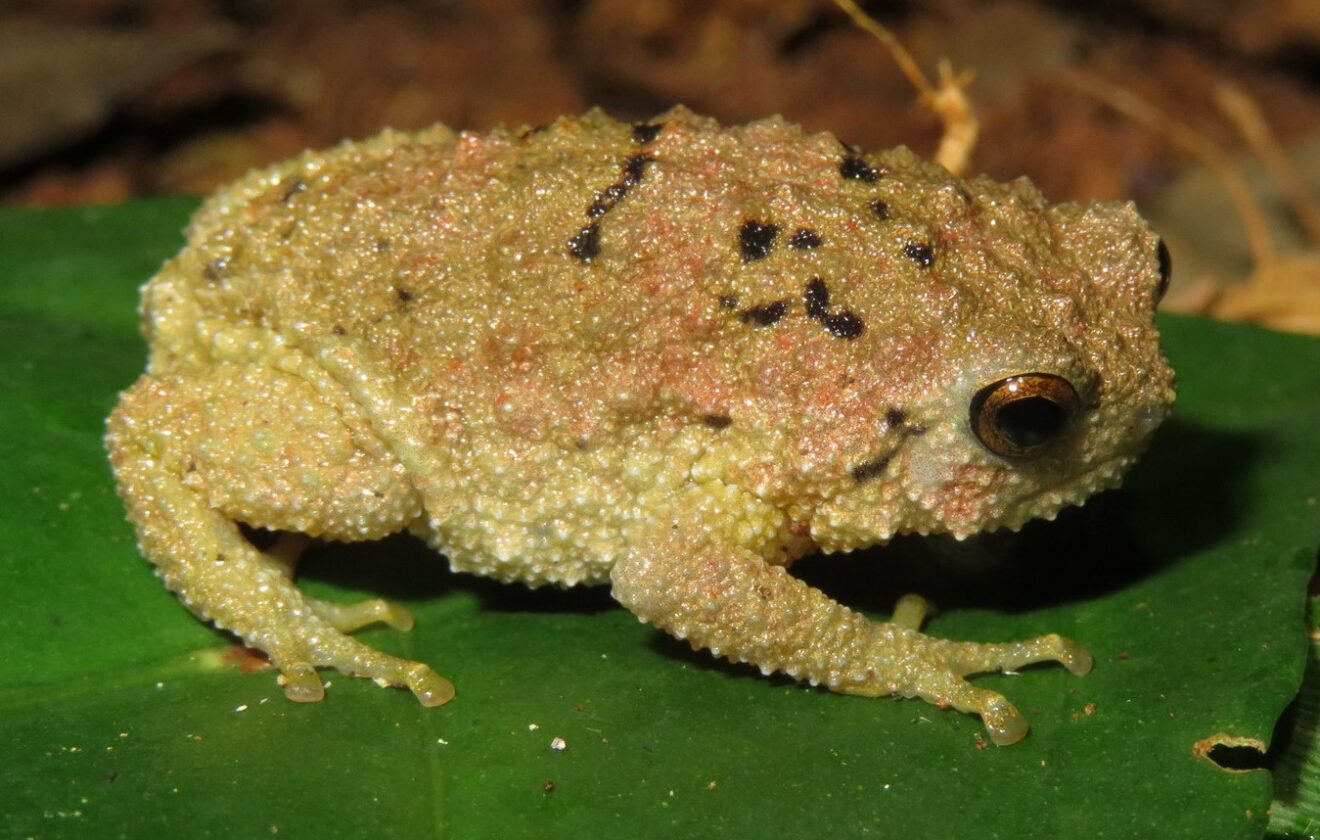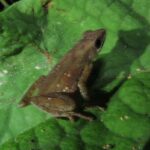- Unveiling the Secrets of Callulina kreffti: Tanzania's Enigmatic Forest Gem
- Taxonomy and Classification
- Natural Habitat: Jewel of the Eastern Arc Mountains
- A Portrait in Miniature: Physical Characteristics
- Behavior and Life Cycle: Quiet Giants of the Miniature Realm
- Ecological Guardians: The Role of Callulina kreffti
- Under Siege: Threats and Conservation Status
- A Cultural and Scientific Symbol
- Conclusion: Protecting Tanzania’s Forest Jewel
Unveiling the Secrets of Callulina kreffti: Tanzania’s Enigmatic Forest Gem#
Hidden beneath dense layers of misty Tanzanian forests lives a small, elusive amphibian whose quiet existence reveals much about the delicate balance of life in this vibrant yet fragile ecosystem. Callulina kreffti, known colloquially as Krefft’s Warty Frog, enchants those lucky enough to glimpse its secretive ways. Previously overlooked, this fascinating forest dweller has gradually garnered attention as both a charismatic example of biodiversity and a poignant emblem for conservation.
Named aptly for its distinctive textured skin and the German herpetologist Gerard Krefft who first documented its existence, Callulina kreffti encapsulates the allure and intrigue inherent to Tanzania’s biodiversity hotspots. Yet despite its intriguing charm and scientific interest, this amphibian faces an uncertain future, reliant upon the collective resolve of humanity’s dedication to preserving the world’s forests.
Taxonomy and Classification#
Belonging to the family Brevicipitidae, Callulina kreffti fits comfortably into a small genus—Callulina—characterized by oval-shaped bodies and notably textured skin. Amphibians within this genus have evolved adaptive specializations uniquely suited to their particular climatic niche, notably the moist and cool habitats characteristic of Tanzania’s Eastern Arc Mountains.
The genus Callulina contains several closely related species, each boasting specific adaptations that aid survival in their microhabitats. However, C. kreffti stands out due to its carefully adapted morphology and notable isolation at select mountain locales. This frog’s highly specialized characteristics make it an intriguing subject for herpetologists seeking insights into adaptive evolution in amphibians.
Natural Habitat: Jewel of the Eastern Arc Mountains#
Geographic Range and Endemism#
Endemic exclusively to Tanzania, Callulina kreffti occupies a limited stretch spanning the Usambara and Uluguru mountain ranges—key constituents of the famed Eastern Arc biodiversity hotspot. These ancient mountains, enveloped by mist-laden cloud forests, house myriad unique forms of life, each remarkably adapted to the wet, cool conditions perpetuated by eastern Africa’s climate and geography.
Habitat Preferences#
Within these humid montane forests, Callulina kreffti finds refuge in a direct connection to the forest substrate. The species thrives on leaf litter, hidden within moist mossy cover, beneath rotting logs, and amid densely tangled roots. Given the perpetual moisture and moderated temperatures here, these frogs rarely face dehydration, allowing specialized skin adaptations to flourish. Every shade-dappled niche found beneath the lush canopy contributes to their covert lifestyle, enhancing their survival chances by ensuring their habitats remain sheltered from predators and harsh climatic extremes.
The forest floor’s microhabitats offer protection, warmth, moisture retention, and, most importantly, crucial sources of food—tiny arthropods providing necessary nourishment throughout their lifecycle. Thus, the intricately dynamic ecology of the Eastern Arc Mountains enables such specialist amphibians as C. kreffti to persevere despite their otherwise sensitivity to environmental changes.
A Portrait in Miniature: Physical Characteristics#
While many tropical frog species are vibrant, flashy characters, Callulina kreffti sports a more reserved yet equally fascinating appearance. Adults typically measure no more than 40mm in length. Its body shape appears compact, rounded, and robust—attributes perfectly suited to its terrestrial habitat. But perhaps the most striking characteristic of this species lies in its exceptionally warty, textured skin, sculpted into an intricate mosaic of granulated bumps and ridges.
Coloration is a captivating blend of earthy hues, predominantly browns, olive greens, and muted yellows, offset subtly by darker blotches that provide camouflage on moss-covered terrain and leaf litter. The coloration and texture effectively mimic the forest’s organic matter, allowing these frogs to evade detection by predators and prey alike, a core adaptation defining their survival strategy.
Behavior and Life Cycle: Quiet Giants of the Miniature Realm#
Feeding Habits and Predation#
Primarily insectivorous, C. kreffti patiently prowls leaf litter, employing an ambush strategy to capture small invertebrates. Typical prey includes mites, ants, springtails, and occasionally small beetle larvae. Their method of hunting relies on stealth and patience, utilizing their excellent camouflage to slowly creep closer to unsuspecting prey before an incredibly precise strike with their elongated sticky tongues.
Mating and Reproductive Strategies#
The breeding behavior of Callulina kreffti remains one of its most intriguing aspects. Unlike many amphibian species whose reproduction is closely connected to pools, streams, or standing water, C. kreffti showcase remarkable terrestrial adaptation. Females lay eggs directly onto moist soil or hidden substrate pockets rather than in water. This adaptation not only ensures eggs are protected from aquatic predators but also greatly reduces dependency on available water bodies—making this frog a unique example of evolutionary ingenuity.
After mating, females deposit relatively large and yolk-rich eggs in secure spots concealed beneath the leaf litter. Uniquely, this species skips the free-swimming tadpole stage completely; instead, the hatchlings emerge directly as miniature, terrestrial froglets—fully capable and remarkably independent from the age of first leap.
Ecological Guardians: The Role of Callulina kreffti#
While small and elusive, C. kreffti fulfills several critical ecological roles within its forest ecosystem. As a predator of diverse small insects, this species helps regulate prey populations, thus contributing substantially to maintaining balance among forest invertebrates. In turn, Krefft’s Warty Frog itself provides sustenance for larger predators, including birds, snakes, and mammals, highlighting its function as a vital link in the delicate food chain of these forests.
This species also serves as a sensitive environmental sentinel; their health and population density closely indicates habitat quality. Because of its reliance specifically on pristine forest conditions, conservationists monitor this frog closely, using fluctuations in its populations as an early-warning mechanism indicating broader changes and threats to the forest ecosystem as a whole.
Under Siege: Threats and Conservation Status#
Despite its unique adaptations and critical ecological functions, Callulina kreffti faces significant conservation threats linked primarily to habitat degradation and loss. Deforestation driven by unsustainable logging, agriculture encroachment, road construction, and the ever-present threat of human settlement expansion undermine the integrity of its equally fragile habitats. Furthermore, global climate change exacerbates these threats, altering precipitation patterns and ambient temperatures, thereby compromising the frog’s finely tuned niche.
Recognized officially by the International Union for Conservation of Nature (IUCN), the current Red List categorizes Callulina kreffti as “Endangered,” underscoring the urgency required for dedicated conservation efforts. Focused initiatives include habitat protection, community awareness, scientific monitoring, and advocating for sustainable land-use practices. Conservation actions aim not solely at preserving the species but also promoting the well-being of the broader ecosystem that frogs like C. kreffti symbolize.
A Cultural and Scientific Symbol#
Although lesser-known culturally, frogs such as Callulina kreffti subtly influence local folklore, representing symbols of health and balanced ecosystems in native cultures inhabiting the Eastern Arc region. Scientifically, the species shines as a showcase for evolutionary adaptation, providing valuable insights into amphibian biology, adaptation mechanisms to terrestrial habitats, and the extracted lessons critical for broader biodiversity management strategies.
Conclusion: Protecting Tanzania’s Forest Jewel#
The well-being of Callulina kreffti, while seemingly minor on the global stage, speaks profoundly about humanity’s relationship to nature. Protecting this species means safeguarding an ancient ecosystem filled with beauty, complexity, and immeasurable ecological importance. Responsible human intervention and conscientious stewardship become our collective responsibility—to not only halt its decline but also cherish the delicate dance of coexistence embodied in this small, enchanting frog. By advocating for forest conservation, we affirm our role as conscientious guardians of the world’s vulnerable natural heritage. The future of Callulina kreffti depends squarely upon our decisions today.








